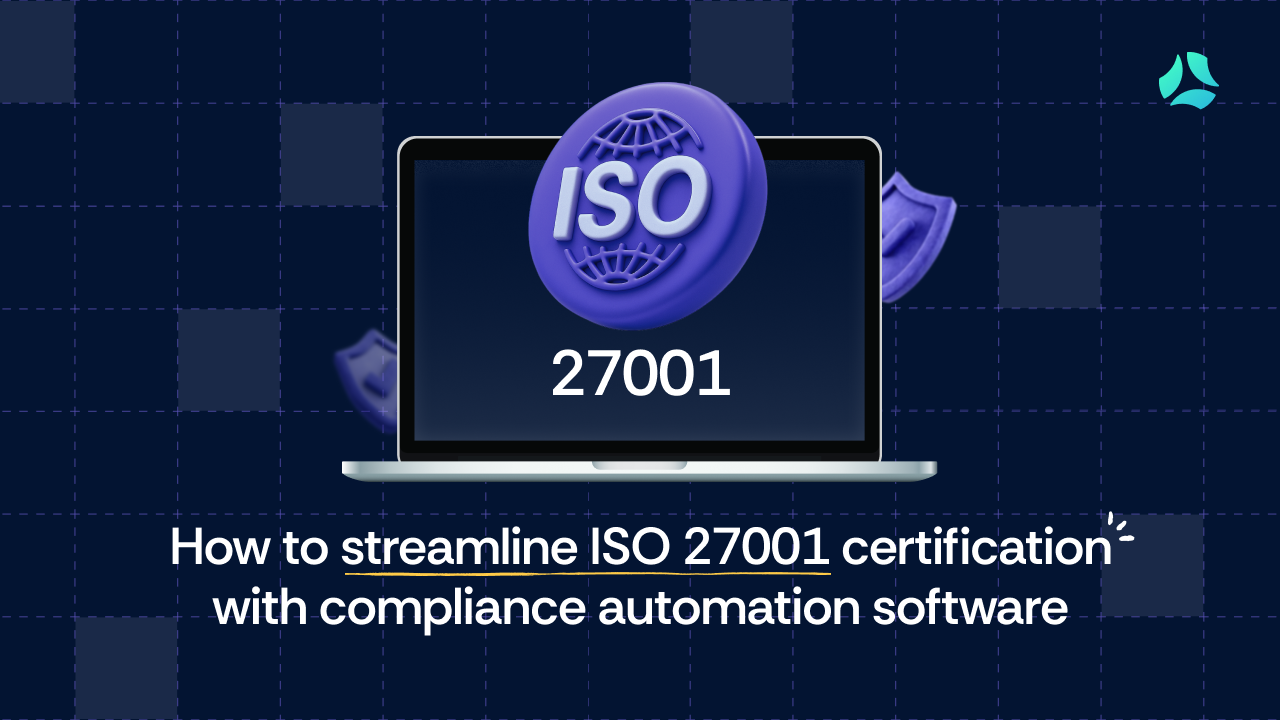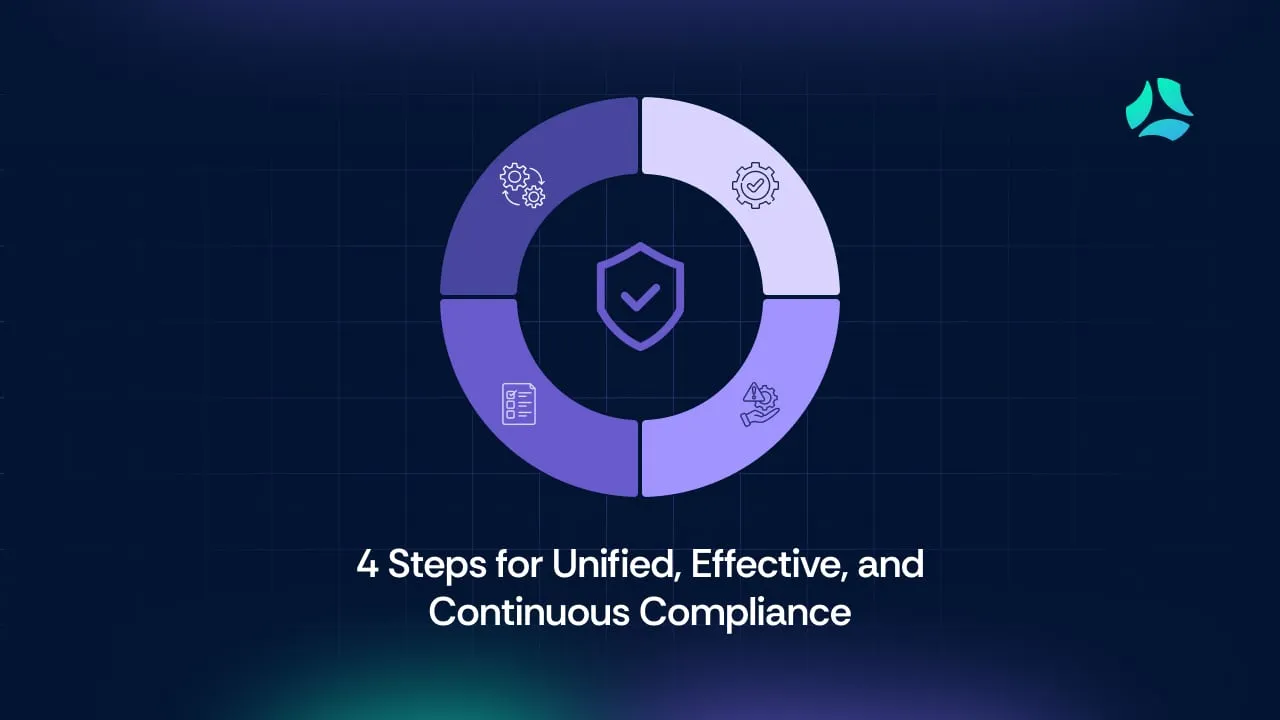ISO 27001 compliance automation: How to simplify your audit & certification in 2025

In 2025, ISO 27001 remains the global benchmark for building and maintaining an effective ISMS. But it’s no longer just about getting certified.
It's about proving that security is baked into how your business operates.
With expanding threat surfaces across cloud-native stacks, distributed teams, and third-party integrations, annual audits and manual reviews just don’t cut it. Most teams are juggling multiple platforms and compliance frameworks, leading to misconfigurations, blind spots, and mounting operational risk.
That’s where automation comes in. It replaces fragmented, manual efforts with a system that continuously maps controls to real configurations, flags misalignments in real time, and generates audit-ready evidence on demand.
The result? Faster fixes, consistent enforcement, and an ISMS that’s always up to date. No scramble, no surprises.
In this guide, we break down how ISO 27001 compliance automation helps you simplify audits, reduce manual overhead, and build a security-first culture that scales.
What is ISO 27001 compliance automation?
Compliance automation brings your policies, controls, and monitoring into a single, always-on loop.
Instead of juggling spreadsheets and chasing evidence manually, automation ensures continuous controls monitoring and real-time visibility.
It frees up your team to focus on fixing gaps and responding to risks instead of just checking boxes.
At its simplest, ISO 27001 compliance automation software is one that:
- Has the official controls and clauses of ISO 27001 into a structured framework.
- Maps your organizational policies, risks, and systems directly to those controls.
- Continuously gathers proof that each control is active.
- Alerts you to deviations and tracks your remediation efforts.
If you update a policy or deploy a new service, the system rescans and confirms that your control mappings still hold true, ensuring nothing falls through the cracks.
When you switch from manual to automated, you cut weeks off your audit prep time and reduce human error, so your team isn’t scrambling at year-end to gather proof.
- Control mapping: All controls are preloaded (e.g., Annex A controls) and automatically linked to your policies, systems, and evidence artifacts.
Real-time dashboards highlight any mapping gaps, enabling rapid remediation. When you onboard a new system—whether it’s a cloud database or endpoint management tool—you you map systems to specific Annex A controls, with the mapping stored centrally.
- Evidence collection: Through integrations with cloud-native platforms (AWS, Azure, GCP) and enterprise tools, scans run regularly—often hourly or daily—to capture logs, configurations, and policy versions. Snapshots are bound to specific controls for audit readiness.
If a configuration file changes or a user’s role is updated, the automation platform captures that event, tags it to the relevant control, and stores it in an auditor-friendly format.
- Continuous monitoring: Automated checks detect deviations—whether a config drift, privilege change, or expired policy—instantly triggering notifications and remediation actions. This ensures you’re always one step ahead of audits.
When a policy drifts or a vulnerability emerges, you receive an alert containing both the finding and a suggested remediation path, ensuring you act before auditors raise the issue.
Manual vs. automated processes: what’s the difference?
By embracing ISO 27001 compliance automation, you transform a year-long audit scramble into an integrated, ongoing practice.
You gain confidence that controls are not only implemented but continuously monitored, with clear accountability for their enforcement. Automation strengthens oversight by surfacing gaps early, but consistent policy adherence, management action, and human review remain essential to maintaining a security posture that withstands both internal requirements and external scrutiny.
Key challenges in ISO 27001 implementation
ISO 27001 implementation often begins with good intentions but real-world obstacles like paperwork overload and team misalignment quickly arise.
1. Documentation overload
ISO 27001 requires maintaining a comprehensive set of documents—such as policies, procedures, risk registers, and a Statement of Applicability—all of which must be regularly reviewed and kept up to date.
Organizations often drown in version confusion and misplaced files. When documents don’t match actual processes or aren’t easily accessible during audits, it can lead to inconsistencies and inefficiencies. Use standardized templates, centralize your documentation, and set a regular review cadence so nothing slips through the cracks.
2. Lack of cross-functional coordination
ISO 27001 compliance isn’t just a security or IT project. HR, legal, ops. They’re all in. Without clear ownership and communication, teams duplicate effort or overlook key controls.
Set up a steering committee. Assign control owners. Use a shared platform to keep everyone aligned and accountable.
3. Scattered evidence
Auditors expect evidence that each selected control is properly implemented and operating effectively. However, this evidence—such as logs, training records, and test results—often resides across multiple systems, making manual collection time-consuming and prone to oversight.
This scattered approach can result in missing items during audits and reactive firefighting to locate proof. A centralized repository, metadata tagging, traceability mapping, and automated collection tools simplify evidence management and keep audits stress-free.
4. Falling short of auditor expectations
Auditors look for more than documents. They expect an ISMS that’s fully operational, with engaged leadership and staff who understand their roles. If your SoA isn’t current, or your team isn’t ready to explain how controls work in practice, you’re likely to get flagged during the audit.
So what should you do? Keep your SoA up to date. Run internal audits ahead of the real one. Train your team so they know how their role supports the ISMS.
Features to look for in ISO 27001 compliance automation tools
Choosing the right ISO 27001 compliance automation platform isn’t just about convenience. It’s about ensuring your ISMS is mapped, monitored, and maintained with minimal manual effort.
Here are the key capabilities your ISO 27001 automation solution should include to keep you audit-ready and aligned with the standard.
1. Control mapping to ISO clauses
Many teams lose hours chasing spreadsheets to track which ISO 27001 requirements and controls they’ve already addressed. With automation, your tool can pre-map all 114 Annex A controls to relevant risks, policies, and evidences—helping you quickly identify coverage gaps.
For example, if a new data encryption control is introduced, the dashboard updates instantly to show which areas are compliant and which still need attention. The result? A clear, auditable trail from each control to its implementation, keeping you continuously audit-ready without the manual effort.
2. Pre‑built policies for ISMS
Writing every ISMS policy from scratch can delay your certification by weeks, and introduce inconsistencies. By using customizable templates that already reference the exact controls they enforce, you eliminate guesswork.
If you update your access control policy, the platform automatically ties that change back to the relevant Annex A controls and tracks versions as you route documents for approval. You get consistent, compliant policies in days instead of months, with full version history at your fingertips.
3. Integration with cloud infrastructure and SaaS tools
Manually exporting logs and configuration snapshots often means your evidence is outdated before you even upload it. With built‑in connectors to your cloud environments and business applications, the ISO 27001 automation solution runs posture tests on scheduled or event-based scans, and flags misconfigurations. It links each finding to the relevant control.
When a configuration drifts from your baseline, you’re alerted in real time.
4. Task management and audit logs
It’s one thing to collect evidence automatically, but proving who did what and when is just as critical. With built‑in workflows, you assign tasks, such as evidence collection or policy review, with deadlines and reminders that go straight to the responsible person’s inbox.
Every action is recorded in an immutable log, capturing user, date, and activity. Auditors gain read‑only access to a curated view of controls, policies, and evidence, so you eliminate email chains while maintaining full traceability.
5. Continuous control monitoring and alerts
ISO 27001 certification isn’t one-and-done. Even after certification, controls can drift, leaving you vulnerable until the next audit. Continuous monitoring runs real‑time scans of both technical settings and procedural checks, sending instant alerts if something slips out of alignment.
If a user permission change violates your access control policy, the system not only notifies your security team but also documents the deviation and its remediation. You catch issues proactively and demonstrate ongoing risk management without waiting for an auditor’s findings.
How Scrut helps you automate ISO 27001 compliance
Scrut simplifies the entire compliance lifecycle by combining policy templates, 24-hour risk monitoring, and seamless evidence automation—all purpose-built to help you implement and maintain ISO 27001 compliance with greater speed and confidence.
1. Ready-to-use ISO 27001 framework
Scrut’s platform comes with a built-in structure that mirrors the ISO 27001 standard, including a pre-configured risk register and risk scoring workflows. This means you don’t need to build your ISMS from scratch.
As you select risks from Scrut’s library or create new ones, the system automatically maps them to annex A controls and generates mitigation action items. This ensures you start with a fully aligned ISMS blueprint, reducing setup time and helping you meet risk-based requirements from day one.
2. Auto collection of control evidence
Instead of manually pulling logs, screenshots, or configuration files from multiple systems, Scrut has over 100+ integrations and runs continuous checks. When a configuration drifts or a log changes, the platform captures a timestamped snapshot and links it directly to the appropriate Annex A control.
The result? Always up-to-date, audit-ready evidence without the manual effort or last-minute scrambling.
3. Built-in ISMS policy templates
With more than 75+ auditor-ready policy templates—including for information security, incident response, and access control—Scrut saves you from drafting long-form documents.
Each template is already linked to its respective ISO control, and in-platform editing makes it easy to tailor content to your organization. Approval workflows and version histories help maintain consistency and audit transparency. This feature keeps your documentation precise, aligned, and ready for review any time.
4. Dashboards and task tracking for audits
Scrut provides an intuitive dashboard that shows control effectiveness, outstanding audit tasks, evidence gaps, and non-conformities all in one place.
Automated task assignments, reminders, and audit-status updates keep everyone on track. Because every action is logged with a user and a timestamp, you have a clear trail of accountability. Inviting auditors into a read-only view further streamlines the audit process, demonstrating compliance confidently and efficiently.
5. Timeline and milestone tracking for certification readiness
While Scrut doesn’t publicly list a specific timeline view, its task and project features let you define certification goals, set milestones, and monitor progress.
By assigning deadlines and tracking status updates directly in the system, you can follow your ISMS rollout in real time. This builds a clear roadmap toward certification, helps prevent bottlenecks, and ensures that nothing falls through the cracks as your audit approaches.
It calls for an ongoing, resilient security posture. The right ISO 27001 compliance automation platform not only streamlines audit workflows and risk assessments but also embeds compliance into the fabric of your operations.
With automated control checks, pre‑mapped policy libraries, and seamless integration across your tech stack, you’ll spend less time on routine tasks and more on strategic initiatives.
Ready to transform how you manage information security? Discover how Scrut’s ISO 27001 automation solution can help you build a living, breathing ISMS. Schedule your demo today!


















